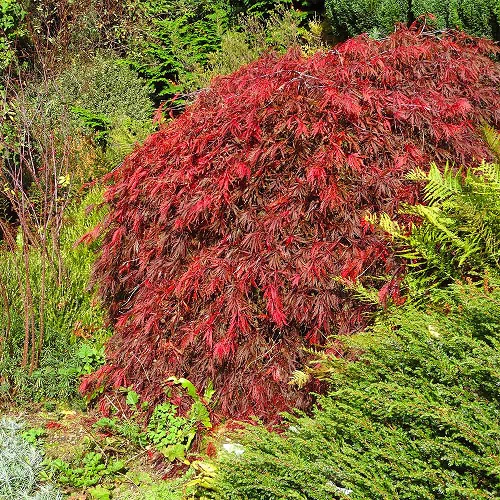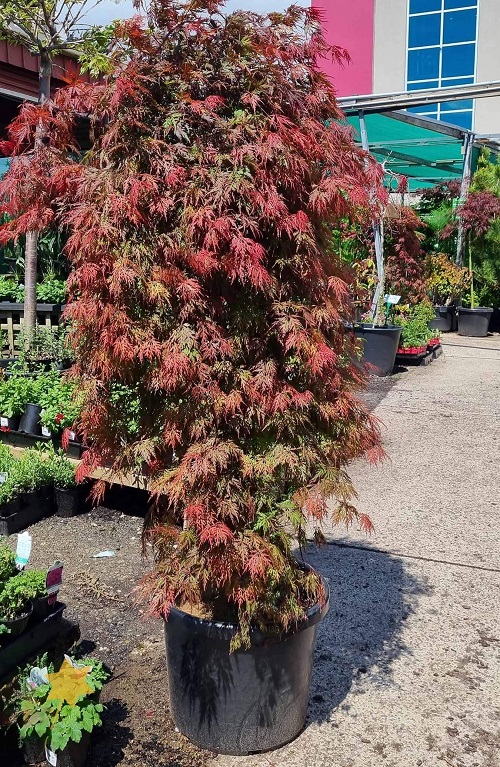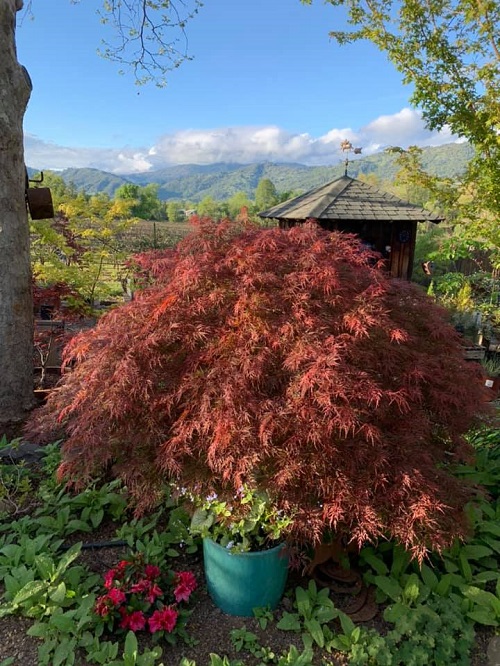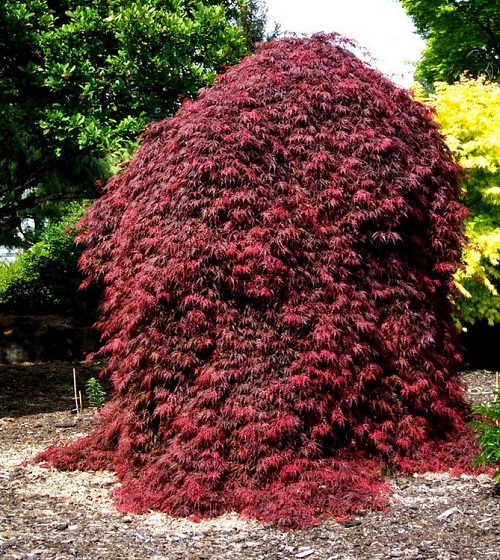Here’s all the Orangeola Japanese Maple information – from its origins and cultural significance to care guidelines and propagation methods.
Dive into a comprehensive guide on Orangeola Japanese Maple information, covering its rich history, care requirements, and everything you need to know.
Botanical Name: Acer palmatum dissectum ‘Orangeola’
Pacific Sunset Maple Tree Growing Guide
Orangeola Japanese Maple Information
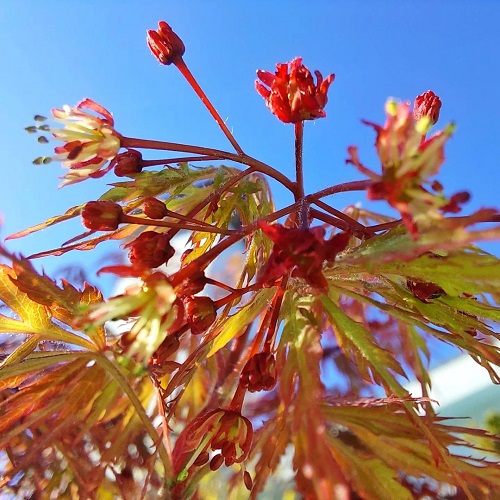
The Orangeola Japanese Maple originates from Japan, where it is part of the rich tradition of Japanese gardening. It belongs to the broader Acer palmatum species, which has been cultivated in Japan for centuries for its diverse leaf shapes and colors.
Flowers
- Appearance: The flowers of the Orangeola Japanese Maple are small and delicate, with a somewhat inconspicuous nature. They typically have a reddish or purplish hue, complementing the tree’s overall color palette. The flowers are arranged in clusters and have a subtle charm that adds to the tree’s aesthetic.
- Blossom Time: The Orangeola Japanese Maple usually blossoms in the spring, typically before its leaves fully unfurl. The exact timing can vary based on climate and local conditions, but the tree’s blossoms contribute to the early-season beauty of gardens and landscapes.
Note: While the flowers of the Orangeola Japanese Maple are understated, it is the tree’s stunning foliage that takes center stage in its aesthetic appeal. Emerging in vibrant shades of orange-red in spring, the leaves transition to deep red or bronze as the season progresses, creating a captivating interplay of colors.
Check out Tamukeyama Japanese Maple Growing Information here
Propagating Orangeola Japanese Maple
Ways to Propagate Orangeola Japanese Maple
- Seeds
- Softwood Cuttings
- Hardwood Cuttings
- Air Layering
- Grafting
- Budding
- Layering
- Division
The Most Popular and Reliable Method: Grafting
Grafting is often considered the most reliable method for propagating Orangeola Japanese Maple due to its ability to preserve specific traits, ensure faster maturity, maintain consistency, and provide strong root system support.
Propagating Orangeola Japanese Maple via Grafting
- Select Rootstock: Choose a healthy rootstock tree that is compatible with the Orangeola variety.
- Choose Scion: Select a young, vigorous shoot from the Orangeola Japanese Maple that displays desired traits.
- Prepare Rootstock: Make a clean, diagonal cut on the rootstock’s stem. This cut should be about the same diameter as the scion.
- Prepare Scion: Trim the scion to include at least one bud and a small section of wood. The cut should match the angle of the rootstock cut.
- Join Scion and Rootstock: Gently insert the scion into the rootstock cut, ensuring that the cambium layers of both align. Bind them together with rubber bands or grafting tape.
- Seal Graft Union: Apply grafting wax or a sealing compound to the grafted area to prevent moisture loss and infections.
- Provide Care: Place the grafted plant in a controlled environment with high humidity, like a greenhouse, and monitor for successful union.
- Gradual Exposure: After the graft has taken hold, gradually expose the plant to outdoor conditions. Monitor growth and health regularly.
How to Grow a Japanese Maple Tree in a Pot
Advantages of Grafting
- Preservation of Traits: Grafting ensures that the new plant inherits all the specific traits and characteristics of the desired Orangeola Japanese Maple variety, such as leaf color and shape.
- Faster Maturity: Grafted plants tend to grow and mature more quickly compared to methods like seeds or cuttings. This means you’ll have a fully developed tree sooner.
- Consistency: Grafting produces uniform plants that are genetically identical to the parent plant. This consistency is especially important when propagating cultivars with specific aesthetic qualities.
- Root System Strength: The rootstock used for grafting can provide better root system development and support than cuttings or other methods, leading to improved overall tree health.
Choosing a Container for Orangeola Japanese Maple
Opt for a container that provides ample space for the tree’s root system to grow, allowing it to thrive. A pot with a capacity of at least 10 to 15 gallons is recommended for young trees, while mature specimens might require larger containers.
Additionally, opt for a container made of durable materials like clay or high-quality plastic, which help regulate soil moisture and temperature effectively. The right container, coupled with proper care, will contribute to the health and beauty of your Orangeola Japanese Maple, whether it graces a patio, deck, or garden space.
Plant Pot Sizes from Inches to Gallon
Requirements for Growing Orangeola Japanese Maple
Sunlight
The Orangeola Japanese Maple thrives in partial shade to filtered sunlight. While it can tolerate some direct morning sun, it’s crucial to provide protection from intense afternoon sunlight to prevent leaf scorch.
Shield the Orangeola Japanese Maple from strong afternoon sunlight (Especially if you live in warm regions), as its delicate foliage is susceptible to sunburn. Placing it under the canopy of larger trees or providing shade during the hottest part of the day helps maintain its vibrant color.
Soil
The Orangeola Japanese Maple thrives in well-draining soil that retains moisture without becoming waterlogged. A mix of organic-rich soil, such as compost-enriched potting mix or loamy soil, promotes healthy root growth and overall plant vitality.
Maintain a slightly acidic to neutral soil pH range for the Orangeola Japanese Maple, ideally between 5.5 and 7.0. This pH level ensures that the tree can effectively absorb essential nutrients from the soil.
How to Make Your Own Potting Soil | Potting Mix Recipes For Everything
Watering
The Orangeola Japanese Maple benefits from consistent and moderate watering. Water the tree when the top inch of the soil feels slightly dry to the touch. During its establishment phase, ensure regular watering to encourage healthy root development.
When watering the Orangeola Japanese Maple, aim for deep and thorough saturation. Use a soaker hose or drip irrigation system to deliver water directly to the root zone, minimizing moisture on the foliage. This approach helps prevent fungal diseases and encourages the roots to grow deeply into the soil.
Note: Avoid overwatering, as soggy soil can lead to root rot. Regularly check the soil’s moisture level to strike the right balance for the tree’s hydration needs.
Temperature
The Orangeola Japanese Maple is best suited for USDA hardiness zones 5 to 9, which corresponds to temperature ranges of approximately -20°C to -5°C (-4°F to 23°F) in the coldest winters and around 1°C to 30°C (34°F to 86°F) during warm summers.
Orangeola Japanese Maple Care
Fertilizer
Use a balanced, liquid fertilizer such as a 10-10-10 or 14-14-14 ratio. Go for brands like Brands like Miracle-Gro, Schultz, and Dyna-Gro. Feed the Orangeola Japanese Maple in:
- Early Spring: As the tree breaks dormancy
- Late Spring: As new leaves fully develop
- Early Summer: To bolster summer growth
1 tablespoon of liquid fertilizer per gallon of water is recommended while feeding the plant.
DIY Potassium Rich Plant Fertilizer | Homemade Potassium Fertilizer Recipe
Pruning
Pruning the Orangeola Japanese Maple is crucial for maintaining its health and appearance. It’s best done during the dormant season, typically in late fall or winter, to minimize stress. Remove dead or diseased branches, thin out crowded growth, and shape the tree by making clean cuts just above nodes or buds.
Careful pruning enhances air circulation, prevents disease, and ensures the tree’s graceful form is maintained, contributing to its overall beauty in your landscape.
Pests
- Aphids: Small, soft-bodied insects that feed on new growth, causing distorted leaves and producing honeydew.
- Scale Insects: Tiny, immobile insects that attach to branches and leaves, sucking sap and causing yellowing and sooty mold.
- Japanese Beetle: Metallic green beetles that skeletonize leaves by feeding on their tissue, leading to lacy foliage.
- Caterpillars: Larval stage of various insects that consume leaves, potentially causing defoliation if their populations are high.
- Spider Mites: Tiny arachnids that suck sap from leaves, causing stippling and a bronzed appearance.
- Leafhoppers: Insects that feed on sap, leading to stippling and yellowing of leaves.
Types of Common Pests in Your Garden & How to Get Rid of Them
Diseases
- Verticillium Wilt: Causes wilting, browning, and eventual death of branches; fungus in soil blocks water transport.
- Anthracnose: Leads to brown, irregularly shaped spots on leaves; can cause defoliation in wet conditions.
- Powdery Mildew: Creates white powdery patches on leaves; thrives in humid conditions.
- Leaf Spot: Causes circular brown spots on leaves; usually not a serious threat to overall tree health.
- Canker Diseases: Results in sunken, discolored areas on branches; can lead to dieback if severe.
FAQs
1. Can I Grow Orangeola Japanese Maple Indoors as a Bonsai?
Yes, Orangeola Japanese Maple can be cultivated as a bonsai. Its delicate foliage and compact growth habit make it a popular choice for bonsai enthusiasts. Select a suitable pot and follow bonsai care guidelines for a stunning miniature version of this tree.
2. How Can I Protect Orangeola Japanese Maple During the Winter Months?
Providing a layer of mulch around the base of the tree in late fall helps insulate the roots and retain moisture during winter. Additionally, shielding the tree from harsh winds and extreme frost can help maintain its health through colder months.
Most Essential Container Garden Design Tips
3. Can Orangeola Japanese Maple Be Grown in Containers on a Balcony or Patio?
Yes, Orangeola Japanese Maple can be successfully grown in containers on a balcony or patio. Choose a container with adequate drainage, use well-draining soil, and ensure the tree receives the right balance of sunlight and protection from harsh elements.
4. How Do I Know if My Orangeola Japanese Maple Is Getting Enough Water?
Check the moisture level of the soil by inserting your finger about an inch deep. If it feels slightly dry, it’s time to water. Remember to provide deep watering rather than frequent shallow watering to encourage healthy root growth.

